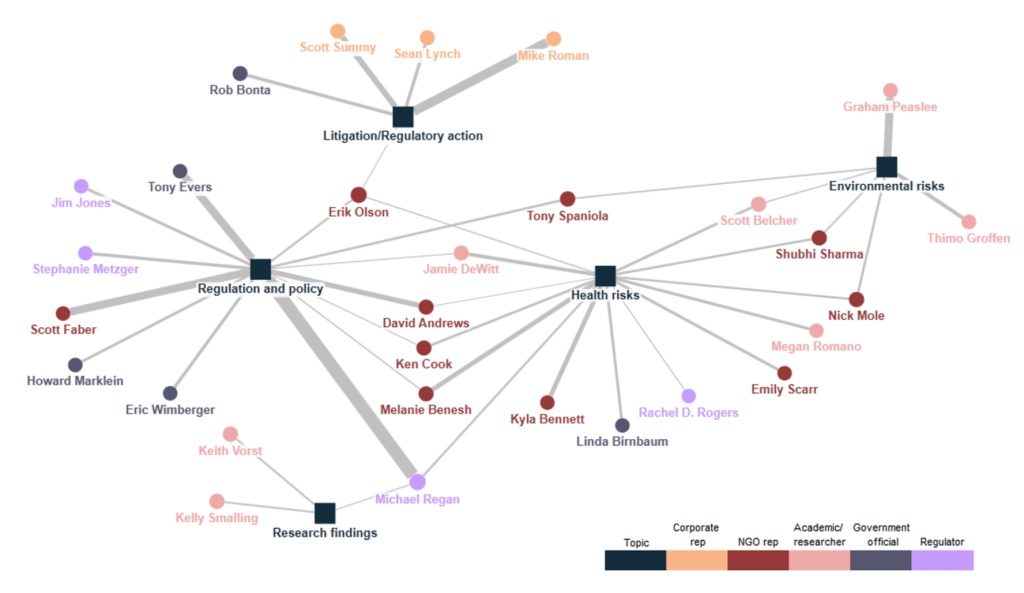As PFAS or “forever chemicals” are on the verge of becoming a mainstream issue, companies can apply a risk comms approach to protect their reputations.
PFAS is quickly becoming a real reputational danger
Much has changed since we analysed the debate around PFAS (per- and polyfluoroalkyl substances, or “forever chemicals”) a year ago. Back then, it was just entering the media conversation.
But since then, billion-dollar lawsuits accusing major chemical companies, including 3M, Chemours, Corteva and DuPont, have been continuously making headlines, placing Litigation and regulatory action at the heart of the media coverage, as per our analysis of 1,036 English-language articles published between June 2023-June 2024.
So it seems our prediction that PFAS would turn into a major reputation risk came true. The question is – now what?
A risk comms approach
Risk communication (part of both risk management and crisis communication) is all about making sure that targeted audiences understand how risks affect them. Risk comms is a speciality of governmental institutions or intergovernmental organisations- think of how the World Health Organisation communicated around Covid.
However, we think risk comms can be an effective strategy for corporations as well, especially when it comes to issues like PFAS, where the science is rapidly evolving, the exposure is perceived as involuntary, and risk management strategies are a moving target.
Here are the top three ingredients of a risk comms plan:
1. Take responsibility even if you didn’t create the problem
The first step to a good corporate risk comms plan is to claim an issue as your own even if you didn’t create it. It sends a clear message that your company is not shying away from responsibility.
This is especially pertinent for industries beyond chemicals exposed to PFAS-related reputational risk.
You might think that the chemical sector is at the centre of it all – and for now, it’s still the focus of the conversation. However, only recently have companies realised the presence of PFAS in their own supply chain, and as such the media has recently started reporting on food & drink companies, such as McDonald’s and Burger King, fashion brands like REI and Patagonia, FMCG players like Unilever and retailers like Walmart.
And just because fashion, food & drink or FMCG companies didn’t create the whole PFAS situation doesn’t mean they should be afraid of taking responsibility and claiming the issue as their own.
Not doing so could mean that someone else—regulators, environmentalists or government officials —takes control of the narrative. And when someone discovers that your company has PFAS in its products, “it wasn’t me!” probably won’t cut it as an excuse.
2. Tap into the first-movers advantage
Being proactive on PFAS won’t just allow companies to cut down on public relations risk. It could also permanently cement their place as leaders and experts on the issue, building lasting credibility with customers, media and other stakeholders who are looking for answers.
So far, not many corporates have been truly proactive. This is illustrated on the map below, which shows the links between the topics in the media debate (represented by squares) and the companies (represented by circles).

It was mainly fashion brands that stood out in the Corporate action to limit PFAS topic – for example, outdoor brands like Alpkit, Lowe Alpine, Patagonia, Dick’s Sporting Goods and REI earned some positive media exposure as they announced plans to remove the PFAS from many of their products.
And among food & drink companies, McDonald’s stood out for phasing out wrappers containing PFAS.
However, the PR benefits of first movers across many industries are still up for grabs.
3. Become the first point of truth
Having taken responsibility and been proactive, the last step – and the ultimate success of risk comms – is when you become a risk authority. This is when you become the first point of truth that the media turns to for accurate PFAS information.
So far, the PFAS media debate has been largely dominated by activists, academics and government officials.
Corporate spokespeople like 3M’s chairman and CEO, Mike Roman, were the smallest part of the pie and are featured in the Litigation and regulatory action topic, as they tried to defend their companies:

To become a risk authority, you should be well familiar with what kinds of risks are gaining traction – in our research sample, those were the increased risk of certain cancers (e.g., prostate, kidney, and testicular cancers), decreased fertility and elevated cholesterol levels:
It might also be useful to take stock of other experts who are frequently cited in the media as explaining PFAS risks. As seen in the map above, those can be academics like Scott Belcher, a North Carolina State University professor who researches PFAS toxicity, or Jamie DeWitt, a professor of pharmacology and toxicology at at East Carolina University who studies water contamination.
Now might be a good time to become familiar with them and their work, and use it to inform your strategy.
